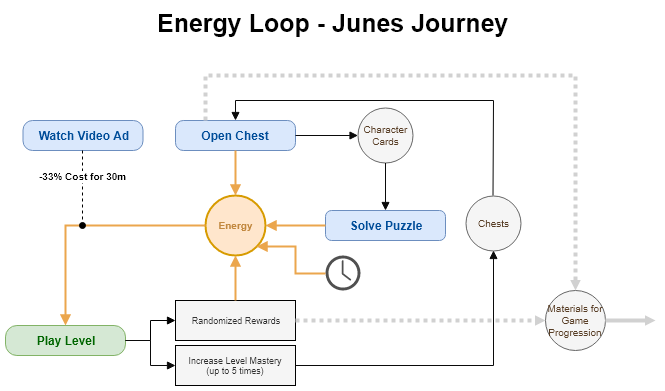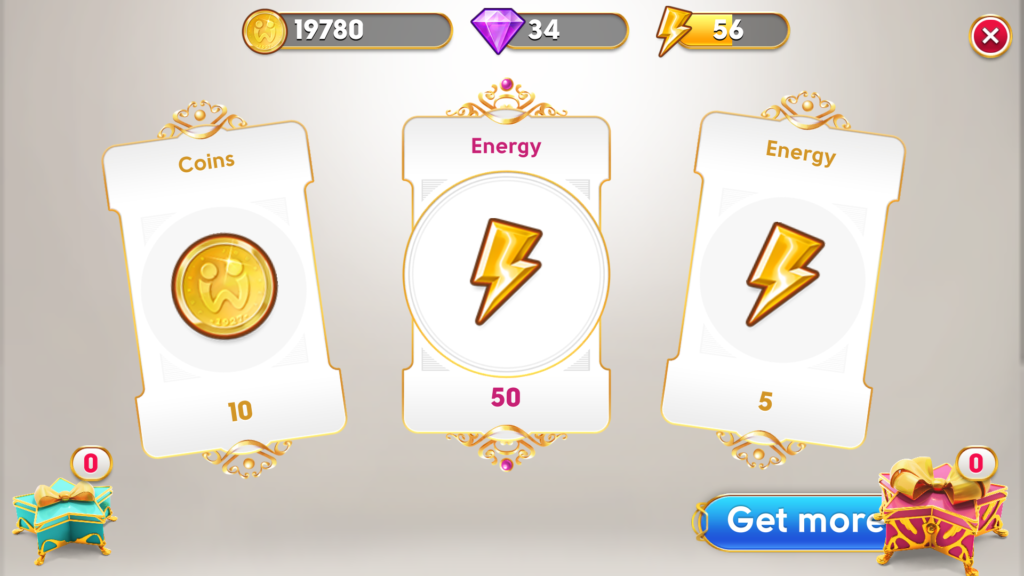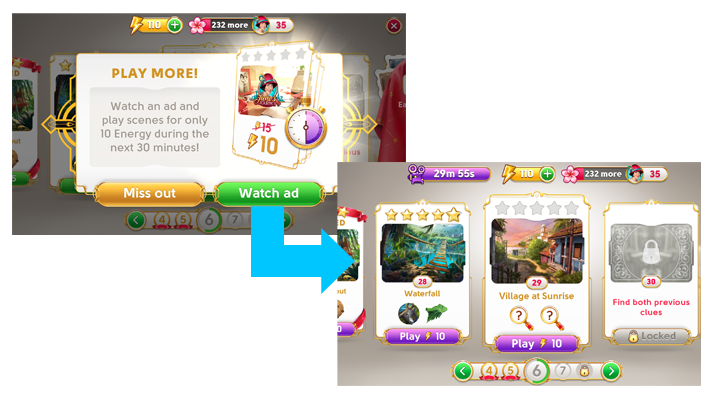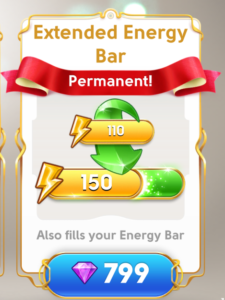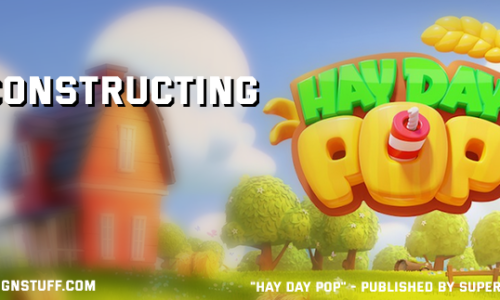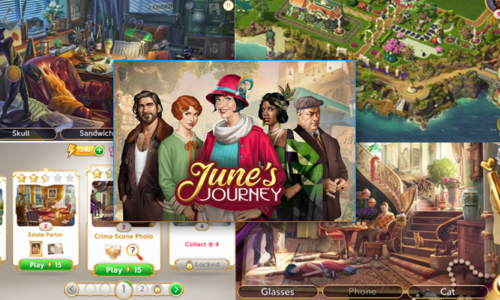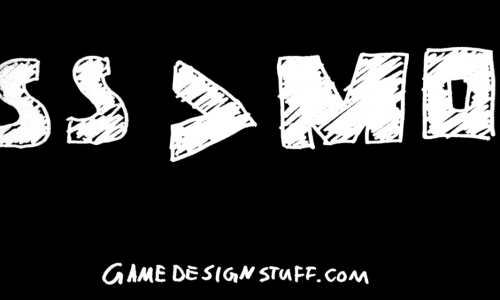In this article, I want to outline how you can give your game a boost by letting players own their sessions. As an example, I will use mechanics and systems that I found in “Junes Journey” – Woogas latest Free to Play Hidden Object game for Mobile devices. The game show-cases how mobile games can provide small empowering choices that lets players strategize in meaningful ways with their energy-economy.
Session Pacing
In a previous article I gave an overview of the importance of session design in mobile games, and how it is implemented across various games. In short, session design is an essential part of mobile free to play design. Players should be able to get a significant amount of satisfaction within a somewhat predictable time. That’s what makes them come back. Then there is a mechanic that paces them to the next session.
These mechanics are usually things that are on a schedule: a bucket of missions filling up, energy/lives being refilled, or crops being ready to harvest. This is the essential loop of the “byte-sized” fun in mobile free to play games.
Junes Journey Empowering Session Design
Junes Journey runs on a pretty straightforward energy-system. At the expense of energy, you play Hidden-Object Scenes. Energy replenishes over time. So you play a couple of scenes until you run out. And then you wait or monetize at the end of your session.
However, after playing for a couple of days and touching base with all of the different progression mechanics, I noticed that I had some control over my energy economy. Various mechanics and features are tied into the energy system. And they don’t just extend it arbitrarily, no – they let players decide. Multiple sources allow players to modify their energy economy. These can be earned or purchased. The critical point is, players can save these “tokens” and trigger them whenever they want. As game creators, we should seize every opportunity to let players feel smart. June’s Journey is achieving this through various mechanics/systems
Chests
Chests are rewarded for completing content. For each “Star” a player receives (Stars are earned by accumulating score over multiple gameplays and when a level has 5 stars, it’s completed). Chests contain Energy, Building Materials, and Character Cards. The content is randomized. Players can also purchase the chest for money. Giving these chests “for free” upon completing content is a smart move. My guess is, that a big portion of June’s Journeys monetisation is rooted in these chests. By making chests part of the core loop, players get used to using the feature regularly. They learn the value of this purchasable item over time. It is not this “alien money feature”, with uncertain value.
A critical aspect of chests is, that they are collected in an inventory. The game does not just give progression rewards to players, they can open them at their own discretion.
Players can pile up these chests, and when they feel they want to roll the dice for some extra energy they can open them – chances for Energy in a chest are quite high.
Video Ads
Most successful free to play games harness the power of video ads. It is more appealing to the masses, as they don’t need to spend money, however, the return per ad is very low. That’s why most games incorporate incentivized video ads in their core loop. In Junes Journey, video ads are implemented in a very powerful way.
For watching a video ad, players can start Hidden-Object-Scenes for less (33%) energy for 30 minutes. This essentially turns a 10minutes session into a 20minute session. It’s almost a must-have, if players want to play smart. It is also a commitment by the player. By watching the ad – “investing” the time – they commit to playing until their energy runs out – to make the best use of the bonus that they were granted. So not just does the game generate Ad-Revenue through this feature, it also increases time spent in the game, which is usually never a bad thing (unless you’re running out of content)
Character Cards
Character cards are obtained from the aforementioned chests. And therefor is another resource, diverted from the core gameplay loop. The cards go into a pool. When all cards of a character have been collected, players can complete a puzzle. As a reward for this puzzle, players can trigger a full energy bar one-time, whenever they want. Character cards are on a quite long loop, but it is an interesting side mechanic that also expands the narrative of a game by revealing more information about the world’s characters.
Random Energy
The game also drops a bit of energy randomly from individual gameplays. This does not add to the player’s autonomy – quite the opposite – I would argue that adding the uncertainty of a length of a session is not necessarily best for every player. There are players who will be happy with any bit of energy they get because they’ll just play as long as they can. For others, just craving a certain experience, adding more energy is just inducing a bit of loss aversion. However, players of type 1 are probably more common, so overall it’s probably still a viable mechanic – but I see some room for improvement for addressing different player types here.
Increased Energy Maximum
This ridiculously expensive permanent upgrade lets players increase the maximum amount of energy that their bar hold and thereby increasing the number of gameplays, players can squeeze out of each session.
The Perfect Session
These are all the features interacting with the energy economy, of which most are at the player’s discretion. Each of these systems is tied into the core loop in a slightly different way to address a multitude of use-cases and player-types.
The power of all of these features is visible when looking at them as a system. A system that lets players create their “perfect session”. Players accumulate cards, chests, trigger the video ad and suddenly they have created a super long & rewarding session for themselves. I can’t stress enough, how important it is, that the players are utilizing the game’s mechanics to execute their plan of creating this situation for themselves.
Conclusion
By giving players control over these peripheral systems, the game governs control of the session length to the player. The idea of extending the session of a player by granting extra energy is not new. But in games, every detail matters. A seemingly small mechanical change can have a big impact on the player’s experience.
Respecting Players
Many other games fill up the energy bar on a level up or other markers in the game’s progression. However, I argue that that is not necessarily the best implementation for casual mobile games. We never know in what situation the player is. Maybe they are just prepared for their 2-5minute session and they can not make use of your gift. The gift turns into a curse. Players might feel like they’re missing out.
Reward & Anticipation
Players earn those extended sessions by completing content. Completing content to earn rewards, already an integral part of the games’ loop. This system diverts a bit of those rewards into a bucket. A bucket that the player can use when they want. They can withhold some of their rewards for later use.
Autonomy
Games should strive to provide players with some autonomy over their journey. Autonomy is a corner-stone for successful games. But especially casual mobile games, struggle to design and implement features that provide decisions. Systems that provide a high degree of autonomy are usually quite complex – e.g. Crafting Systems, Tech/Skill Trees, Branching Narrative. But this system grants players small pockets of freedom that empower players.




